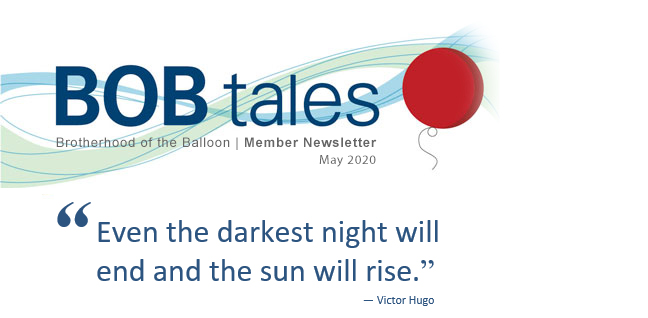
Dear Members (a note from Bob Marckini):
To paraphrase Mark Twain, “The news of my demise has been greatly exaggerated.” One of our members emailed Deb asking why he hadn’t heard from me in a while, and he assumed the worst. Heavens! Fact is, I’ve been taking more time for myself and Deb has been doing more and more, thankfully.
Last month I celebrated my 77th birthday. Where has time gone? It seems that a very short time ago I was in my 40s. In all honesty, I’ve never felt better in my life, and I truly feel like I’m still in my 40s, exercising vigorously every day (I’ve swum a thousand miles in the past six years) and eating a healthful diet. And now that Deb is running things, I have a little more time to play golf, enjoy the theater, take vacations, try new restaurants, and spend time with family and friends. But wait – I can’t do any of those things right now. The dreaded coronavirus – specifically COVID-19 – has taken control of our lives.
I mentioned celebrating my birthday in April, but not in the way I’d expected. In our home, birthdays are usually a big deal. We always get together as a family; Pauline bakes her special dark chocolate cake with silky-smooth mocha frosting; we open birthday gifts and have dinner together. This year was different. It was just Pauline and me and a Zoom teleconference with my daughters, Susie and Deb, my son-in-law, Mark, and my granddaughter, Gemma. How sad the way this terrible virus is isolating people from each other!
It gets worse. Barber shops and hair salons are closed. I haven’t had a haircut in two months, and it will be at least another month before the shops open. By then I’ll probably have a ponytail. And with all this isolation, I’ve given some thought to growing a beard … again. Last time I did this was about 15 years ago. I thought I might look like a celebrity – perhaps George Clooney – who was sporting a full beard at the time. I was half right; I did look like a celebrity, but it wasn’t George Clooney. It was Willie Nelson. So, if I grow the beard again during this sequestration, and wind up with a ponytail, I’ll have to dust off the old guitar and start learning the words to, “On the Road Again.” I guess there’ll be no beard.
I make light of the effects of COVID-19 on our lives, but it’s no laughing matter. In this month’s BOB Tales Deb does a terrific job covering several aspects of the virus, especially the latest in prevention and mitigation. To report any statistics could be misleading because things change so rapidly. There are, however, early signs of a flattening of new diagnoses and mortality rates. Also doctors and researchers are talking about several promising drugs and vaccines undergoing trials. So, there’s hope on the horizon.
 To get our minds off COVID-19 for a bit, the first week in May is National Pet Week. Pets bring so much comfort and joy into our lives. We hear from members all the time about their pets. Many have shared photos with us. Pauline and I have a framed photo of our beloved “Sadie” hanging in our home. We lost Sadie a little over a year ago and still miss her every day. One of my favorite things to do back then was to place Sadie in the basket of my bike and ride the streets of our sleepy little seaside town. Sadie loved it as much as I. Deb, Mark, and Gemma recently brought home a Goldendoodle, which they named “Lucy.” And just as Sadie did for us, Lucy has quickly taken over their home and their hearts. God knew what He was doing when he brought pets into our lives.
To get our minds off COVID-19 for a bit, the first week in May is National Pet Week. Pets bring so much comfort and joy into our lives. We hear from members all the time about their pets. Many have shared photos with us. Pauline and I have a framed photo of our beloved “Sadie” hanging in our home. We lost Sadie a little over a year ago and still miss her every day. One of my favorite things to do back then was to place Sadie in the basket of my bike and ride the streets of our sleepy little seaside town. Sadie loved it as much as I. Deb, Mark, and Gemma recently brought home a Goldendoodle, which they named “Lucy.” And just as Sadie did for us, Lucy has quickly taken over their home and their hearts. God knew what He was doing when he brought pets into our lives.
Have I told you that we have some extraordinary members in our group? Deb received a ton of emails after last month’s newsletter where she wrote about her daughter Gemma’s challenges with dyslexia. Members wrote her about struggles they’ve had with their own children – some adopted like Gemma – how they handled the challenges, and the incredibly positive outcomes. They also offered encouragement and prayers. One of our members, a teacher, told Deb that he has taught lots of kids with dyslexia, and found that learning and playing chess can be beneficial to those children. So, he mailed Deb a chess set that he refurbished, and he’s planning to teach Deb, Mark, and Gemma how to play using Zoom video conferencing. What incredible members we have!
We have, once again, a full and comprehensive newsletter this month. In addition to a COVID-19 update, we are covering topics including new proton vs. IMRT studies, tips on tolerating hormonal therapy, another new proton center coming, prostate imaging breakthroughs, predicting advanced disease, attempts to force insurers to cover proton therapy, and some exciting news about my new book.
Finally, someone sent me an email that said,
When this ends – and it will – every game will sell out; every restaurant will have a two-hour wait; every kid will be glad to be back in school; everyone will love their job; the stock market will skyrocket; every other house will get TP’d; and we’ll all embrace and shake hands. That’s going to be a pretty good day. Hang in there, world.
Hopefully, this will happen soon.
Bob Marckini
P.S. Raswsi Williams once said, “To do what nobody else will do, a way that nobody else can do, in spite of all we go through; that is to be a nurse.” May 6 is National Nurses Day. No one needs to be reminded about the role nurses play in our lives, especially at a critical time like this. Nurses, doctors, other medical professionals, and first responders are on the firing line every day, not just during this COVID-19 pandemic, but always. They give selflessly of themselves and often receive little recognition. This is a good time for us to go out of our way to acknowledge these heroes for all the comfort, compassion, and caring they generously provide every day.
We hope you enjoy this month’s BOB Tales and, as always, we welcome and anticipate your valuable feedback. Please send an email to [email protected].
To print the BOB Tales newsletter or view the newsletter with a larger font size, click here for the PDF file.
In This Issue:
- Lung Doctor Dispels Rumors and Provides Practical Tips for COVID-19 Pandemic
- Coronavirus: Are Prostate Cancer Patients at Risk?
- Improved Imaging for Identifying Aggressive Prostate Cancer at an Early Stage
- Genetic Study Can Predict Advanced Disease
- Doctor with Brain Cancer Sues Blue Cross: Three New Bills Would Make State Plan Cover Proton Therapy
- The Importance of a Second Opinion
- National Geographic: Secrets of Long Life
- Heart Healthy = Prostate Healthy
- How Cancer Patients and Survivors Can Manage Stress Through COVID-19 Uncertainty
- It’s Never Too Late to Improve Your Diet


In Viral Video, Lung Doctor Dispels Rumors and Provides Practical Tips for COVID-19 Pandemic
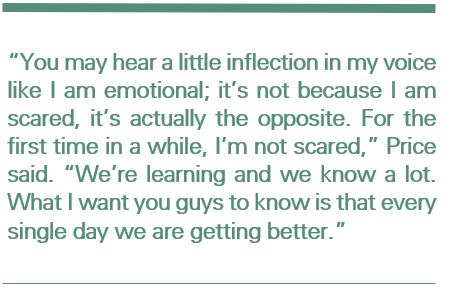 With the onslaught of news and information on the coronavirus pandemic, it can be hard to find reliable information. Lucky for us, Dr. David Price, a critical care pulmonologist (aka lung doctor) at Weill Cornell Hospital in New York City, recently shared his thoughts on video.
With the onslaught of news and information on the coronavirus pandemic, it can be hard to find reliable information. Lucky for us, Dr. David Price, a critical care pulmonologist (aka lung doctor) at Weill Cornell Hospital in New York City, recently shared his thoughts on video.
The hour-long recording was meant to provide reassurance to anxious family members and friends, but it was uploaded and sent to the hospital’s medical staff as well. From there, it quickly went viral. It’s been watched nearly 4 million times.
Following is a summary:

How COVID-19 is Spread
According to Dr. Price, the vast majority of COVID-19 transmission is droplet-based. This means touching your face with infected hands that likely picked up the virus on a dirty surface. Throughout the video, Dr. Price reiterates this point several times.
If you’ve watched the news lately, you may be hearing more and more that the virus can be spread through talking or even just breathing. Dr. Price concurs, however this is where the distinction of “sustained contact” is important. Aerosol transmission likely happens by spending extended time in a confined space with someone who is “aerosolizing” the virus (e.g. coughing, sneezing).

How to Protect Yourself
Keep Your Hands Clean!
“We know that if you keep your hands clean, you’re not going to get this,” Dr. Price said. Sounds simple. So why is it spreading so quickly? Most people aren’t aware of how many times they touch their face (the average is 23 times an hour, according to a study in the American Journal of Infection Control).
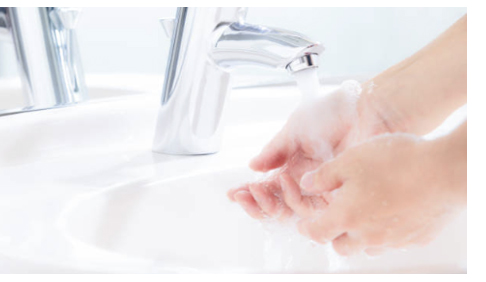 Dr. Price carries hand sanitizer with him everywhere. If you don’t have hand sanitizer, push buttons with your elbow; open doors with your sleeve; etc. When you get home, wash your hands before you do anything else. Then go back and disinfect your doorknobs.
Dr. Price carries hand sanitizer with him everywhere. If you don’t have hand sanitizer, push buttons with your elbow; open doors with your sleeve; etc. When you get home, wash your hands before you do anything else. Then go back and disinfect your doorknobs.
You should also wear a face mask in public; it can train you not to touch your face. Dr. Price is very clear that you don’t need a surgical mask; a simple cloth mask will do. Read more about masks on the following page.
Note Dr. Price didn’t mention wearing latex gloves. We searched the Internet for trustworthy information on this and found most doctors advise against wearing them. Many suggest wearing gloves may actually do more harm than goood. While the gloves can protect your hands from coming in direct contact with germs, the virus can remain on the surface of the gloves for an extended period of time unless they’re washed. Gloves can also create a false sense of security. Regular hand washing is a better defense against the virus.
Keep Your Distance!
Social distancing, also called “physical distancing,” means keeping space between yourself and other people outside of your home. In his video, Dr. Price suggests 3 to 6 feet, but most suggest 6 feet minimum and some have recently suggested 10 feet. This helps to avoid breathing in droplets if the person near you coughs, sneezes or even talks.
Social distancing also means don’t gather in groups; stay out of crowded places/mass gatherings; and don’t hug or shake hands with anyone.
“You don’t need to live in a bubble,” says Price. Just keep your hands clean and avoid close sustained contact with people.

What You Need to Know About Face Masks
Since Dr. Price’s video went viral, the CDC has issued a recommendation to wear cloth face masks in public settings where other social distancing measures are difficult to maintain (e.g. grocery stores). The purpose is to slow the spread of the virus and help people who may have the virus and don’t know it from transmitting it to others.
Though Dr. Price mentioned wearing a simple cloth face mask, we’ve since learned from a local news program that it’s important to choose your fabric wisely. Hold it up to a window. If too much light can pass through, it’s probably too porous. Use a thicker, denser material like a dinner napkin. If you don’t have a thicker material, place a couple of paper towels inside the cloth before assembling it.
Learn how to make a simple mask with a bandana and two rubber bands.
Too much work? Wrap a scarf around your face. Remember: The best protection a secured piece of fabric over your mouth and nose offers may be protection from you. When you breathe, talk, shout, burp, hiccup, laugh, yawn, sneeze, or cough in public, you’re less likely to get droplets on a checkout machine, counter top, friend’s face, or anywhere else. That could stop people, even those who are asymptomatic, from spreading infection.

What to Do if You Get Sick
When should you go to the hospital?
According to Dr. Price, you should go to the hospital only if you are short of breath. Don’t go if you just have a fever and cough.
Should you get tested for COVID-19?
If tests are readily available in your area, sure. If not, and you have respiratory symptoms such as coughing, sneezing, sore throat, fever, etc., behave as if you have COVID-19 and quarantine yourself.
How should you quarantine yourself?
If you live with someone who’s older or at high risk, find somewhere else to stay. If that’s not possible, try to stay in one room of your house. Use a seprate bathroom if you can. Avoid touching common surfaces. If you have to come out of your room, social distance yourself. Make sure everyone obsesses about keeping their hands and surfaces clean and avoids touching their faces.
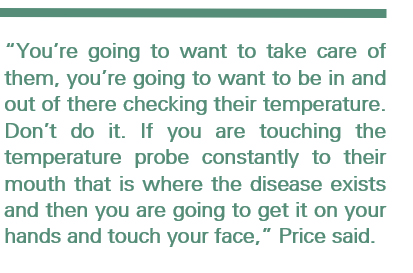 Throughout the world, the vast majority of spread for the virus is between family members.
Throughout the world, the vast majority of spread for the virus is between family members.
Price hopes this information will empower people to feel comfortable in their communities as they wait for this pandemic to end.


Coronavirus and Cancer
The rapid rate of disease spread in the past month has caused response efforts to the coronavirus to transition from containment to mitigation strategies to reduce the public’s risk of contracting the virus, including calls to quarantine sick people; close schools and non-essential businesses; cancel public gatherings, conferences and sporting events; and advise people to stay at home, heading out only to buy food or medicine.
In the oncology community, the response has been swift to protect health-care providers and patients with cancer, who may be especially vulnerable to contracting the coronavirus. These patients may have weaker immune systems due to the type of cancer they have, the type of treatment they receive, other health conditions, and their age.

Are Prostate Cancer Patients at Risk?
It depends on how advanced your cancer is, which prostate cancer treatment(s) you’re receiving, other medical conditions you may have (e.g. diabetes, heart disease, and lung disease), and age.
Refer to the CDC for more information on people who are at higher risk for COVID-19.
Patients With Early-stage Prostate Cancer: According to the Prostate Cancer Foundation’s CureToday.com, if you have early-stage prostate cancer and you’re on active surveillance, are receiving radiation treatment or are scheduled for surgery — you aren’t at increased risk of severe disease with COVID-19. This is because low-grade prostate cancer hasn’t been shown to significantly affect your immune system. Unlike some cancers, early prostate cancer doesn’t affect your T cells’ and B cells’ (i.e., the cells that rule your immune system) ability to fight viral and bacterial infections.
Proton Therapy Patients: We’ve heard from several members who are in treatment ask if they’re at higher risk for coronavirus. We’ve told them that, theoretically, radiation can damage the immune system. However, when treated for prostate cancer, radiation is delivered to one part of the body, so the whole immune system isn’t impacted. Furthermore, since proton therapy delivers less radiation to healthy tissue than conventional radiation,
the effect should be minimal. But you should always check with your doctor.
Patients on Hormonal Therapy: If you’re on hormonal therapy, there’s no published evidence of increased risk of severity of coronavirus infection. However, coronavirus is not a typical virus, so if we learn otherwise, we’ll let our readers know.
Patients on Chemotherapy: Chemotherapy treatment for advanced prostate cancer could increase a patient’s risk of severe disease with COVID-19, though researchers are still monitoring and assessing data on this. Because chemotherapy affects rapidly-dividing cells in the body — both cancerous and normal cells — bone marrow makes fewer infection-fighting cells, potentially leaving the patient at higher risk for infection.
Prostate Cancer Survivors: Regarding the impact of COVID-19 on prostate cancer survivors, there’s no published data.
There’s no specific test to determine if a person is immune compromised, although findings such as low white blood cell counts or low levels of antibodies (also called immunoglobulins) in the blood likely indicate an immune-compromised state.
Read common questions and answers about COVID-19 – for patients and survivors.

The Virus’ Impact on Proton Therapy Centers
All U.S. proton centers are operational and complying with the most up-to-date policies and recommendations from the CDC and local health departments. They’re closely monitoring patients and staff and implementing extra cleaning and sanitation measures. Many are using telehealth for medical visits to limit potential exposure for staff and patients.
Cancer care is an essential medical service and patients should speak to their physician about any concerns regarding cancer treatment during this time.



Improved Imaging for Identifying Aggressive Prostate Cancer at an Early Stage
We’ve reported before on various forms of PET/CT imaging that can help doctors see cancer that could not otherwise be detected with conventional imaging techniques. This is especially important in dealing with advanced cancer or biochemical recurrent cancer.
A recent study, conducted in Australia and published in Lancet on March 22, 2020, compared PSMA PET-CT scan to conventional, commonly used PET-CT scans in 300 men with high-risk prostate cancer.
Researchers concluded that the new prostate-specific membrane antigen (PSMA) was significantly more accurate than the currently used imaging techniques in determining the extent of disease. In fact, the new technique had a 27 percent greater accuracy than conventional imaging for diagnosing pelvic nodal or distant metastatic disease.
“PSMA PET-CT is a suitable replacement for conventional imaging, providing superior accuracy to the combined findings of CT and bone scanning,” researchers concluded. Additionally, both sensitivity and specificity were superior with the PSMA PET-CT scan.
Ga68-PSMA-11 is not approved for use in the U.S., but a new drug application for this imaging agent has been filed with the US Food and Drug Administration.
The study was funded by the Movember Foundation and The Prostate Cancer Foundation of Australia.

Genetic Study Can Predict Advanced Disease
In the UK, a University of East Anglia study found an innovative way to measure gene expression in tumor samples to predict disease severity. Researchers examined gene expression patterns from 2,000 patients, applying a mathematical model called Latent Process Decomposition. Through this, they discovered a specific pattern of gene expression associated with the most aggressive cancers.
The more tumor cells representing that particular pattern the faster the patient will progress to advanced disease. Researchers believe these “DESNT” cells can act as a biomarker to help identify patients who are prone to advanced disease and need more aggressive treatment, even though traditional testing might indicate non-aggressive disease.
This new genetic expression study was published in the British Journal of Cancer.


Doctor with Brain Cancer Sues Blue Cross: Three New Bills Would Make State Plan Cover Proton Therapy
Bryan Hierlmeier is a cardiac anesthesiologist at the University of Mississippi Medical Center. After struggling with painful headaches last spring, he was diagnosed with brain cancer. Following surgery to remove the tumor, his oncologist said he needed radiation and recommended proton therapy because conventional radiation could affect Hierlmeier’s vision and lower his IQ over the coming years, possibly ending his career as a doctor.
Hierlmeier’s health insurer, Blue Cross & Blue Shield of Mississippi, denied coverage for proton therapy three times, saying it was “experimental and investigational.” Hierlmeier and his wife, Lauren, decided to move forward with proton therapy anyway, paying for the treatment out of pocket. They subsequently filed a lawsuit against BCBS, saying that if Hierlmeier underwent traditional radiation therapy, it “would probably result in devastating health consequences that included adverse effects to his vision, memory loss, and cognitive impairment. In other words, [it] would end Dr. Hierlmeier’s career as a professor and practicing anesthesiologist, to say nothing of the impact on the quality of his life,” according to the lawsuit.
Lauren Hierlmeier, who has been quite vocal in the fight against her husband’s insurance provider, said she doesn’t want other families to face the same issue, so she’s advocating for three bills introduced by lawmakers this session.
The bills are all slightly different from each other, but all would require the state’s insurance plan, and possibly all insurance plans, to cover proton therapy. The bills are:
- Senate Bill 2558 would require insurance plans to cover proton therapy;
- House Bill 384 would require the state insurance plan to cover proton therapy;
- House Bill 825 would require insurance plans to cover proton therapy.
As of this writing, Blue Cross has not formally replied to the lawsuit or commented on the bills.
Since undergoing proton therapy, Dr. Hierlmeier has returned to work at UMMC and his family is returning to a sense of normalcy.

The Importance of a Second Opinion
We’ve covered this topic a few times in the BOB Tales, and we’re regularly reminded of the importance of getting a second opinion on medical matters, especially on prostate biopsies. And Bob has written about this in some detail in the new edition of his book.
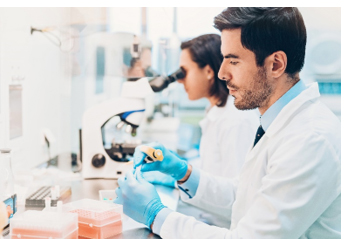 Last month we were contacted by a gentleman in his 70s, who reported a gradual increase in his PSA over the past few years and biopsy results showing mostly 3+3 = 6 Gleason score, with two samples at 3+4. He was seriously considering doing active surveillance, which under certain circumstances would be appropriate.
Last month we were contacted by a gentleman in his 70s, who reported a gradual increase in his PSA over the past few years and biopsy results showing mostly 3+3 = 6 Gleason score, with two samples at 3+4. He was seriously considering doing active surveillance, which under certain circumstances would be appropriate.
We encouraged this man to get a second opinion on his biopsy slides from Dr. Jonathan Epstein’s lab at Johns Hopkins, one of the premier labs in the country, and possibly, the world. The results came back Gleason score 4+3 for one of the two cores that were originally reported to be 3+4; and the other came back as 4+5=9! These are significant changes and they clearly rule out active surveillance.
The good news is this fellow now knows his true diagnosis and can deal with it appropriately. In this case he’ll undergo a combination of hormonal therapy and proton therapy. He’s actually happy to know the truth of his diagnosis, knowing he’s receiving an aggressive treatment that has a good chance of destroying his cancer.
He has since purchased a copy of Bob’s new book and better understands the importance of getting a second opinion.

We have been producing BOB Tales newsletters monthly for almost 20 years. During this time there have been articles that many new members have not seen, and some older members may have forgotten. So, we periodically re-run some articles from past newsletters. This one from November 2005 is titled:

National Geographic: Secrets of Long Life
The U.S. National Institute on Aging funded a study to determine what makes people live longer. Scientists looked around the world and found their answers in three places: Sardinia Italy, Okinawa, Japan, and – are you ready for this – Loma Linda, CA! According to the article, “Residents of these places produce a high rate of centenarians, suffer a fraction of the diseases that commonly kill people in other parts of the developed world, and enjoy more healthy years of life.” So, what are the reasons?
Sardinians: Lifestyle is a large part of what keeps them healthy. They do a lot of physical work every day. Husbands and wives share in all the work, which reduces stress. They share excellent genes that go back 11,000 years to hunter-gathers from the Iberian Peninsula. Their diet consists of home-grown fruits and vegetables including zucchini, eggplant, tomatoes, fava beans, milk from grass-fed sheep and pecorino cheese, which, like fish, contributes protein and omega-3 fatty acids. They drink moderate amounts of red wine, which in their region contains two to three times as much of a component that may prevent cardiovascular disease.
But things are changing in Sardinia. They do less walking now, with more cars and trucks on the island. Obesity is beginning to rear its ugly head, and junk food is making its way into their diet. Clearly these things are having an impact on longevity.
Okinawans: Okinawans attribute their longevity to “ikigai,” or “reason for living.” These are among the world’s longest-lived people, mostly free from disabilities, and maladies such as dementia, cardiovascular disease, breast cancer, and prostate cancer. Okinawans have a strong mutual support network that provides financial, emotional, and social help throughout life. Their diet consists of vegetables, tofu, miso soup, and a little fish or meat. They live by a Confucian-inspired adage “hara hachibue” – which is, eat until your stomach is 80 percent full. They grow much of their own food, and their pantries have been referred to as “cabinets of preventive medicine” by some experts. They contain Chinese radishes, garlic, scallions, cabbage, turmeric, and tomatoes, “compounds that may block cancers before they start.”
Seventh-day Adventists: When I visited Loma Linda last month, I had the pleasure of meeting Marge Jetton, a 101-year-old lady who is featured in the National Geographic article. She drives a car, lifts weights, rides a stationary bike, and spends much of her time “helping older people.” I mentioned the article to her. She told me she was angry at the photo they used of her filling up her car at a gas station. I asked her why and she said, “Because right next to me in the photo was an advertisement for Coca Cola and that has caffeine in it!” According to the article, “The Adventist faith forbids smoking, alcohol consumption and eating biblically unclean foods, such as pork. It also discourages the consumption of other meat, rich foods, caffeinated drinks, and ‘stimulating’ condiments and spices.” Foods that are encouraged include grains, fruits, nuts, and vegetables.
Those of us who are former Loma Linda patients know the importance of the Sabbath to Adventists. According to the article, this is also an important part of their longevity – Adventists live as much as 10 years longer than the rest of us, and they are generally much healthier years. Observing the Sabbath, socializing with other church members and enjoying a sanctuary in time, help relieve stress. Most Adventists today follow the prescribed lifestyle, a testimony, according to researchers, “to the power of mixing health and religion.”
A study conducted by the National Institutes of Health followed 34,000 Adventists. It found their habit of consuming beans, soy milk, tomatoes, and other fruits lowered their risk of developing certain cancers. Drinking five glasses of water a day, eating whole wheat bread, and consuming four servings of nuts a week also reduced their risk of heart disease. Avoiding red meat seemed to help them avoid both cancer and heart disease. Adventists spend much of their time with other Adventists. This helps to reinforce healthy behaviors.
According to researchers, only 30 percent of our longevity has to do with genetics. The rest is up to us. One thing all three areas had in common – no smoking. And, one other interesting note: Researchers found that while negative diet and lifestyle influences are beginning to take their toll – reducing health and longevity in Sardinia and Okinawa – the Adventist lifestyle is gaining strength and acceptance with increasingly positive results. We can learn a lot from our friends in Loma Linda, CA.


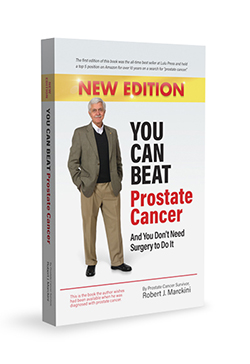 The New Second Edition
The New Second Edition
Last month we shared the wonderful endorsement we received from Dr. Richard Hart, President of Loma Linda University Health. This month we’d like you to see the endorsement we received from Dr. Nancy Mendenhall, Director, University of Florida Health Proton Therapy Institute:
Bob Marckini’s 2nd edition of You Can Beat Prostate Cancer is an outstanding guide for men who have been diagnosed with prostate cancer or, because of age or other factors, are at risk. Through an engaging personal narrative, he distills a plethora of information on the natural history of prostate cancer, countless patient experiences, and extensive published evidence into a few clear concepts that will aid prospective prostate cancer patients in navigating the difficult journey of choosing and completing a treatment strategy and as well as designing a healthy lifestyle to maximize long term treatment success and quality of life. The book is unique in that it provides both a thorough and rigorous investigation into the scientific evidence for specific management strategies as well as the authenticity of his own and others’ lived experiences with various treatment options. All men concerned about prostate cancer should study this book and all physicians who treat prostate cancer should read this book and offer it to their patients.
Thank you, Dr. Mendenhall!

No. 1 on Amazon for the First Time Ever
The second edition has been out just a few weeks and it’s already set records (according to us, anyway). During the first month, it couldn’t be found on an Amazon “prostate cancer” search. There are more than 4,000 books on this subject on Amazon. Then it showed up one day at No. 323, which made us happy. A week later it was at No. 85 and shortly after, it moved up to the top 20.
As of this writing, the book sits in the No. 1 position, while the original book is at No. 5. This is the first time Bob’s book has held a No. 1 position on Amazon (on a “prostate cancer” search). He’s thrilled! Plus, he has two books in the top five. Imagine that! We know that can and will change, but we’re enjoying it while it lasts.

The First Reviews Are In!
Bob is getting a lot of great feedback on the new book from readers who’ve thanked him for helping them understand their diagnosis to others who’ve told him it convinced them to choose proton therapy for their treatment. Nothing makes us happier!
At the time of this writing, the new book has six reader reviews and all are marked as five-stars. Following is the first review that was posted on March 17:
.jpg)
Prostate cancer patients are the beneficiaries of Marckini's work ...
I read Marckini’s first edition and I couldn’t wait to read the second edition. I wasn’t disappointed. Like the first book, this was written in LAYMAN’S language. Easy telling he’s an engineer. His analytical approach to researching each of the treatment options along with their pros and cons was truly revealing. His research was exhaustive, and prostate cancer patients are the beneficiaries of his work. If you’ve been diagnosed with prostate cancer, this is one-stop shopping. Virtually everything you need to know about diagnosis, treatment and the role you, the patient, should play in this process is covered here. I cannot recommend this book highly enough.
Our thanks to PickyButReasonable for this terrific review.
Please note: The Kindle version is free to Kindle Unlimited members or can be purchased for only $9.99, for non-members. The soft-cover price is $22.45
We’re happy to discount books in quantity (20 or more) to anyone who is interested spreading the word on proton therapy. Just send an email to [email protected]
Proceeds from book sales are used to help fund our efforts and to support proton therapy research.


Heart Healthy = Prostate Healthy
Diet: We’ve been writing about the importance of diet for nearly 20 years. A diet low in red meat and animal products, and high in plant-based foods, may help slow down the progression of prostate cancer and reduce tumor growth. Eating healthful foods may also help reduce the recurrence of the disease.
Dr. Mark Moyad, a physician in the department of urology at the University of Michigan Medical Center, states that diet is also good for the heart. “Heart-healthy is prostate-healthy,” says Moyad. “Reducing your cardiac risk as close to zero as possible is the smartest thing you can do as a prostate patient … Maintaining a healthy weight is the first step in becoming heart-healthy.” Moyad also says alcohol is one of the largest sabotages to a heart-healthy and prostate-healthy lifestyle. The caloric content is high, and data show a relationship between excessive insulin production and excessive alcohol exposure. There’s also a link between alcohol and potentially aggressive prostate cancer.
Exercise: We know that regular exercise is good for the heart, but does it also protect the prostate? Dr. Marc Garnick, an internationally renowned expert in urologic cancer at Beth Israel Deaconess Medical Center, thinks so. “I think it’s entirely plausible, though still unproven, that regular exercise could activate genes that either suppress cancer formation or limit the aggressiveness of cancer …” he says. “Exercise also obviously helps you maintain a healthy weight, and there’s considerable evidence that outcomes in men with prostate cancer, regardless of what stage or type of treatment, tend to be worse if you are overweight.”
Medications: Last month, we wrote about statins – drugs used to lower cholesterol – and their potential to help a patient’s survival if they have high-risk prostate cancer. We noted that research also suggests statin medications, used in combination with Metformin (a diabetes medication), can also help prevent certain cancers. Researchers continue to study these medications in prostate cancer treatment – there are dozens of clinical trials under way.

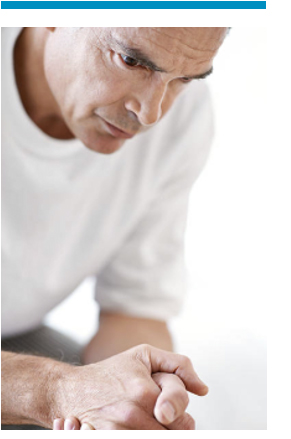 How Cancer Patients and Survivors Can Manage Stress Through COVID-19 Uncertainty
How Cancer Patients and Survivors Can Manage Stress Through COVID-19 Uncertainty
The rapidly evolving coronavirus pandemic has led to significant stress and anxiety in many, particularly those who are in treatment and/or survived cancer. These people are already experiencing (or have experienced) a terrifying, life-changing experience; and now they’re faced with a global virus outbreak.
Dr. Shelley Johns, a board-certified clinical health psychologist and researcher with the Indiana University Melvin and Bren Simon Comprehensive Cancer Center, recommends the following research-supported stress-management skills.
Deepen your connection with others: It may help to take a step back and consider what values you want to embody during this crisis. For example, it may help your emotional state to be compassionate and generous toward others. Work on deepening your connection with friends or family members. There are also plenty of places – many in your hometown – that could benefit greatly from your help. Perhaps you have items (e.g. toilet paper, hand sanitizer) to donate to a local hospital or nursing home. You may have an elderly neighbor you could buy groceries for. Letting your values guide your actions can be extremely gratifying.
Find a practice that can help ground you: Try deep breathing, prayer, or mindfulness meditation. Mindfulness is the basic human ability to be fully present – aware of your thoughts, feelings, bodily sensations, and your environment – rather than getting distracted by thoughts about the future or the past.
Get active: As you probably know, physical activity is also a stress buster. And before you think you don’t have the energy or stamina to “work out,” remember: exercise can be as simple as taking a walk with your dog or doing a few yoga stretches in your living room.
Be grateful: Research has shown that people who feel gratitude are happier, report more life satisfaction, and are less stressed. Keeping a gratitude journal is another way to practice being present and shift your mind to focus on the positive things in your life.
Stick to a schedule: Establishing and sticking to a routine can help you regain control over your life. That can be as simple as waking up and going to sleep at the same time every day. It’s also psychologically and emotionally satisfying to create and adhere to a daily schedule. Checking things off a list after they’re completed is also quite gratifying.
Distract yourself: As you become more stressed, your attention tends to narrow and focus on what you perceive as threatening. Distraction techniques work by interrupting this process of attentional narrowing so that you stop thinking about what’s bothering you and focus on something else. You can also think about this in another way. Instead of turning away from what’s bothering you, you can turn toward what matters most to you. For example, you can clean your closet; work on a craft; or learn something new. Better yet, why not add some of these activities to your daily schedule? Having purposeful activities scheduled into each day can help you maintain your sense of normalcy during this highly unusual time.

What You Shouldn’t Be Doing
as 9/11.
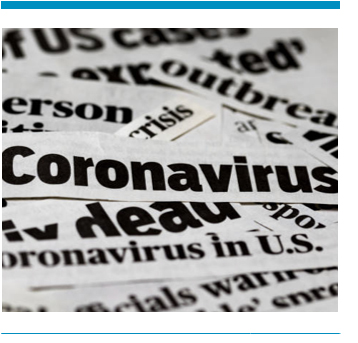 A team of researchers from the School of Social Ecology at the University of California suggests coronavirus media bingeing can lead to “increased anxiety, heightened stress responses that can lead to downstream effects on health, and misplaced health-protective and help-seeking behaviors that can overburden health care facilities and tax available resources.” They cite as an example of misplaced health-protective behaviors the hoarding of toilet paper and hand sanitizer that lead to worldwide shortages of these items.
A team of researchers from the School of Social Ecology at the University of California suggests coronavirus media bingeing can lead to “increased anxiety, heightened stress responses that can lead to downstream effects on health, and misplaced health-protective and help-seeking behaviors that can overburden health care facilities and tax available resources.” They cite as an example of misplaced health-protective behaviors the hoarding of toilet paper and hand sanitizer that lead to worldwide shortages of these items.
Why not schedule news consumption into your daily schedule? Keep it to an hour or less. Consider replacing some of your news consumption with a good book or a puzzle.

It’s Never Too Late to Improve Your Diet
New research shows that changing your eating habits as early as age 40 can help you mitigate weight gain and muscle loss as well as combat a host of chronic diseases, including colon and prostate cancer, when you get older.
No matter your age, however, we believe it’s never too late to improve your diet. An article in Men’s Health suggests a high-fiber diet rich in antioxidants can battle cancers. The habit to break? Avoid carbohydrates. The excess calories may lead to weight gain, which contributes to diabetes. But don’t confuse the bad carbs with the good carbs. Beans, legumes, and wholegrain bread and pasta provide hefty doses of cancer-fighting fiber.

National Proton Conference Goes Virtual
The eighth annual National Proton Conference, which was scheduled for April 26-29, 2020 at the Renaissance Hotel in Nashville, TN, was canceled due to the coronavirus outbreak. After many weeks of evaluating options, the team at the National Association for Proton Therapy (NAPT) has decided to provide a robust one-day virtual conference for attendees, sponsors and exhibitors on Friday, July 24, 2020.
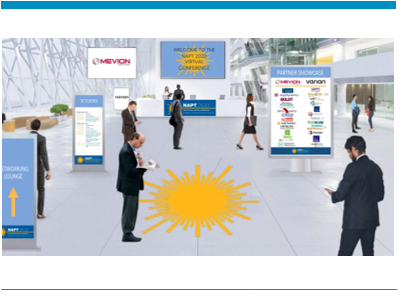 “The proton therapy community has united in the past few months in a way never experienced in our history together,” said NAPT executive director, Jennifer Maggiore. “The COVID-19 outbreak has created an opportunity for us to strengthen our collaborative efforts and support each other. Our annual conference has always been an eagerly anticipated event for our members, technology and
“The proton therapy community has united in the past few months in a way never experienced in our history together,” said NAPT executive director, Jennifer Maggiore. “The COVID-19 outbreak has created an opportunity for us to strengthen our collaborative efforts and support each other. Our annual conference has always been an eagerly anticipated event for our members, technology and
The NAPT executive committee, board of directors, and conference committee agree that a virtual conference is the best way to move forward given the circumstances. NAPT has partnered with Extraordinary Events and will deliver a full-engagement solution offering attendees, sponsors, and exhibitors the ability to easily connect with each other; network with colleagues in virtual chat rooms; and view presentations at their convenience.
For more information or to register, contact Jane Fort at [email protected]

Our Generous Members
As we’ve mentioned before, a large percentage of our members have made gifts to the Robert J. Marckini Endowed Chair for Proton Therapy Research at Loma Linda. Gifts range from a few dollars to tens of thousands, and in a couple of cases, millions of dollars. Some have given once; some give annually, and a few give every month through automatic bank transfers. Several who make routine gifts weren’t even treated at Loma Linda, but they appreciate the role Loma Linda played in their ability to have proton therapy.
This warms our hearts. It sends a strong message that members appreciate the pioneering work that Dr. James Slater and Loma Linda did to make proton therapy available to us cancer patients. It also tells us you appreciate the work we do keeping our 10,000 members in 39 countries together and informed about the latest developments in prostate cancer prevention, diagnosis, treatment in general, and proton therapy in particular, as well as some of the peripheral topics we cover in our newsletter.

Acknowledging Gifts
Each month we attempt to reach out to those who’ve made gifts. We very much want to acknowledge members for their generosity and find out how they’re doing, months and years after their treatment ended. We’ve found it virtually impossible to reach all who’ve made gifts, and eventually, we reach about half of them. Invariably, we hear they’re doing very well with excellent quality of life and no evidence of disease. Almost always, they tell us they’ve read Bob’s book; they love the BOB Tales newsletter; and they’ve recommended proton therapy to friends and acquaintances.

An Example
Last month Bob reached out to one of our members who was treated nine years ago. Each year he makes a gift of tens of thousands of dollars to the Marckini Chair. He told Bob that several investments he’d made had appreciated significantly over time. As these investments matured, rather than liquidate the assets, he had the option of contributing the appreciated assets to charity without having to pay significant capital gains. At the same time, he can deduct the entire gift on his taxes. His charity of choice is LLUH and the Marckini Chair.
This member routinely participates in the annual charity golf tournament at Loma Linda and loves to tour the construction site of the new hospital. He shared with Bob his fond memories of his treatment at Loma Linda; how well he’s doing; and how much he enjoys reading our newsletter, which he routinely forwards to friends. He also noted that he often buys copies of Bob’s book and gives them to friends and acquaintances diagnosed with prostate cancer. Bob told him about his new book and said he’d send him a signed copy as a small token of appreciation for his gift.
We have some wonderful – and generous – members.
Gifts given by this member and so many others help support basic and clinical research efforts, such as hypofractionation trials, Phase III trial on liver cancer treatment, the COMPPARE trial and other ongoing research projects.

Give to Proton Therapy Research
- Donate online.
- Write a check to LLUCC Proton (Put "Marckini Chair" on the memo line) and mail to LLUH, Office of Philanthropy P.O. Box 2000, Loma Linda, CA 92354
- Call Regina Joseph at 909-558-5010.

Give to the LLUH COVID-19 Relief Fund
While Loma Linda University Health is doing all they can to address their community’s healthcare needs during the coronavirus pandemic, they need help. The federal aid hospitals are receiving isn’t enough to meet the needs of their patients, students and staff.
- Learn more about LLUH’s COVID-19 relief fund.
- Donate online.
- Call 909-558-5010.
 Estate Planning Hints
Estate Planning Hints
BOB Member Ron Hendricks is Director, US Foundation for Trinity Western University. He regularly copies us on his “News from Ron” mailings, which are helpful hints on estate planning to the readers of his newsletters. We have found Ron’s suggestions to be timely and beneficial. With his permission we periodically share some of his wisdom with our membership. This segment is called …

Care Plan
If at some point you or someone you love has an illness, or a fear of one; there are several planning options that should be considered. With a serious illness, there are emotional, physical and mental challenges. The illness may be primarily physical, but the person may start to suffer discouragement and even depression.
I know that with my own personal diagnosis of prostate cancer in 2011 the emotional trauma that can go along with a physical diagnosis is significant. I also realized a greater knowledge of God’s protection and power and that He gives wisdom for the decision needed for healing and treatment.
Care of the Person: Several areas are important in thinking through care for the person. You should check to make sure you have a current durable power of attorney for healthcare and finances and share this document with the designated person.
Care of Your Property: If you have a serious illness, it will be important to have a person who has a power of attorney to manage your property, a last will and testament and possibly even a revocable living trust with successors in place.
Financial Accounts: You may have bank accounts, securities accounts and other business accounts. Check to be certain all the accounts are listed on your financial records and your beneficiaries are up to date.
Potential Actions: You may have a current pattern of gifts to family or gifts to charity. If you wish to have your successor trustee continue your gifting pattern you’ll want to give a specific direction to do so.
Advisers and Family: If you are quite ill, it’s important to make sure that you have reliable and trustworthy advisers. Far too many people become weak and are victims of abuse. A group of trusted advisers and family members will protect you and your property


Useless Facts
- The “pound” key on your keyboard (#) is called an octotroph.
- The only domestic animal not mentioned in the Bible is the cat.
- The dot over the letter “i” is called a tittle.
- Nutmeg is extremely poisonous if injected intravenously.
- The Hawaiian alphabet has only 12 letters: A, E, I, O, U, H, K, L, M, N, P, W
- The lighter was invented three years before the match.


Last Month’s Brain Teaser
Which of the following words don’t belong in the group and why?
CORSET, COSTER, SECTOR, ESCORT, COURTS
Answer: Courts. All the others are anagrams of each other (Note: an anagram is a word formed by rearranging the letters of another word.).
Winner: The April brain teaser winner is BOB member Leo Gillman of Plant City, FL. In Leo’s initial email to Deb, along with his answer to the brain teaser, he wrote the following message in response to her opening memo about her daughter’s dyslexia:
I’m praying for you and that beautiful daughter of yours. I can only imagine how you ache with the knowledge that your daughter is being mistreated because of a “defect” (that may well end up being a great blessing instead) in the genetics of Gemma.
Deb was touched by this, particularly because she’s been told repeatedly that Gemma’s dyslexia is a disability, when in fact we may discover one day it’s a very special gift.
Through follow-up emails, Deb learned that Leo, a retired CPA, is a pretty amazing guy. During the pandemic, he’s been helping non-profit organizations, churches, and a few businesses file their applications for SBA loans.
Deb also learned that Leo has a somewhat famous wife! Carolyn Fletcher is a classically trained pianist and can play anything from classical to gospel to country. She’s also a Christian song writer. Carolyn has two solo CDs and she, along with Leo, their two sons, and others, formed a Christian music group that recorded for Benson Records on their Greentree label. The group has performed at churches, concert halls, and college campuses.
Carolyn and Leo have two sons and five grandchildren. Both sons are active Christians who serve in churches. His youngest son is the executive pastor of a large church in Huntsville, AL and his oldest serves as part-time minister of music in a local church in Florida.
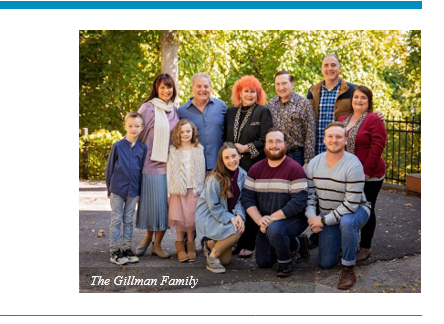 Leo began his prostate cancer journey when his PSA began to rise in early 2002. When it reached six, his family doctor suggested he have a biopsy. Leo visited a clinic, had four core samples taken, and was pronounced cancer free (My, how times have changed!).
Leo began his prostate cancer journey when his PSA began to rise in early 2002. When it reached six, his family doctor suggested he have a biopsy. Leo visited a clinic, had four core samples taken, and was pronounced cancer free (My, how times have changed!).
Over the next few months, Leo’s PSA continued to climb. When it reached 10, his doctor advised him to undergo a 12-core biopsy. “They found cancer dead-center in my prostate,” Leo said. “If they’d stopped before the last two cores, they wouldn’t have discovered it.”
Leo had a friend who’d undergone a prostatectomy, so he called his friend’s doctor and scheduled his own surgery for the summer of 2002. Soon thereafter, Leo began reading about robotic surgery. “That was less invasive and had far less recovery time than open surgery, so I decided to talk to a robotic surgeon.” Leo asked him several questions, including how many surgeries he’d performed. “Thirty,” the doctor replied. This made Leo nervous, so he asked to speak with some of his former patients. Although it took some begging and prodding, Leo was able to contact one man. “He was friendly and accommodating, but he didn’t recommend robotic surgery,” Leo said. “He told me if he had the chance to do it over, he’d have chosen another option.” The man explained that he’d met an anesthesiologist who was diagnosed with prostate cancer. Having treated prostate cancer surgical patients, the anesthesiologist knew he wanted “no part of that.” He chose proton therapy because it’s non-invasive; there’s no down-time; and there are few, if any, side effects.
“I got that anesthesiologist’s phone number and spoke to him for over an hour,” Leo said. After that conversation, Leo called Loma Linda University Cancer Center in CA, the only operating proton center at the time, and asked for a list of former patients. “I spoke to about a dozen before calling LLUCC back and making an appointment. The rest is history.”
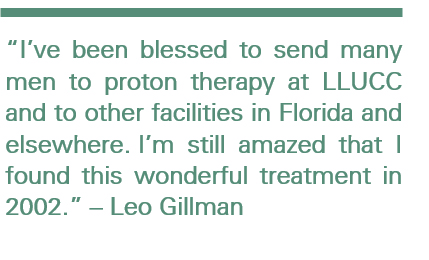 Leo refers to the eight weeks he spent at LLUCC as “the best vacation I’ve ever taken.” He and Carolyn saw all the sites within driving distance, and Leo worked out at the gym three days a week and jogged the other days. When he returned home, Leo’s staff and partners said he looked better than they’d ever seen him. “I felt wonderful,” Leo said.
Leo refers to the eight weeks he spent at LLUCC as “the best vacation I’ve ever taken.” He and Carolyn saw all the sites within driving distance, and Leo worked out at the gym three days a week and jogged the other days. When he returned home, Leo’s staff and partners said he looked better than they’d ever seen him. “I felt wonderful,” Leo said.


New Brain Teaser
A pregnant woman named her children: Dominique, Regis, Michelle, Fawn, Sophie, and Lara. What will she name her next child? This one is tough, but solvable …
Jessica, Katie, Abby or Tina?
Send your answer to [email protected] for a chance to win a signed copy of Bob Marckini’s NEW second edition book, You Can Beat Prostate Cancer.


Sign of the Times?
I stepped on my scale this morning and it said: “Please practice social distancing – only one person at a time.


Oops!
A mother asks her son: “Anton, do you think I’m a bad mom?”
Son: “My name is Paul.”


Yuck!
An old grandma brings a bus driver a bag of peanuts every day. First the bus driver enjoyed the peanuts, but after a month of eating them he asked, “Please granny, don’t bring me peanuts anymore. Have them yourself.”
The grandma answered, “You know, I don’t have teeth anymore. I just prefer to suck the chocolate around them.”

Quote of the Month: "Contentment is not the fulfillment of what you want, but the realization of what you already have." —Unknown


Final Thought for the Times We Are In …
From Kelly’s Treehouse
Going outdoors isn’t canceled.
Listening to music isn’t canceled.
Quality time with people in our home isn’t canceled.
Reading a book isn’t canceled.
Sharing with friends isn’t canceled.
Singing out loud isn’t canceled.
Laughing hasn’t been canceled.
Sharing hope with others hasn’t been canceled.
Let’s embrace what we have.
Stay safe. Stay healthy. And low PSAs to all,
Bob Marckini and Deb Hickey
To print the BOB Tales newsletter or view the newsletter with a larger font size, click here for the PDF file.
NO MEDICAL ADVICE: Material appearing here represents opinions offered by non-medically-trained laypersons. Comments shown here should NEVER be interpreted as specific medical advice and must be used only as background information when consulting with a qualified medical professional.
